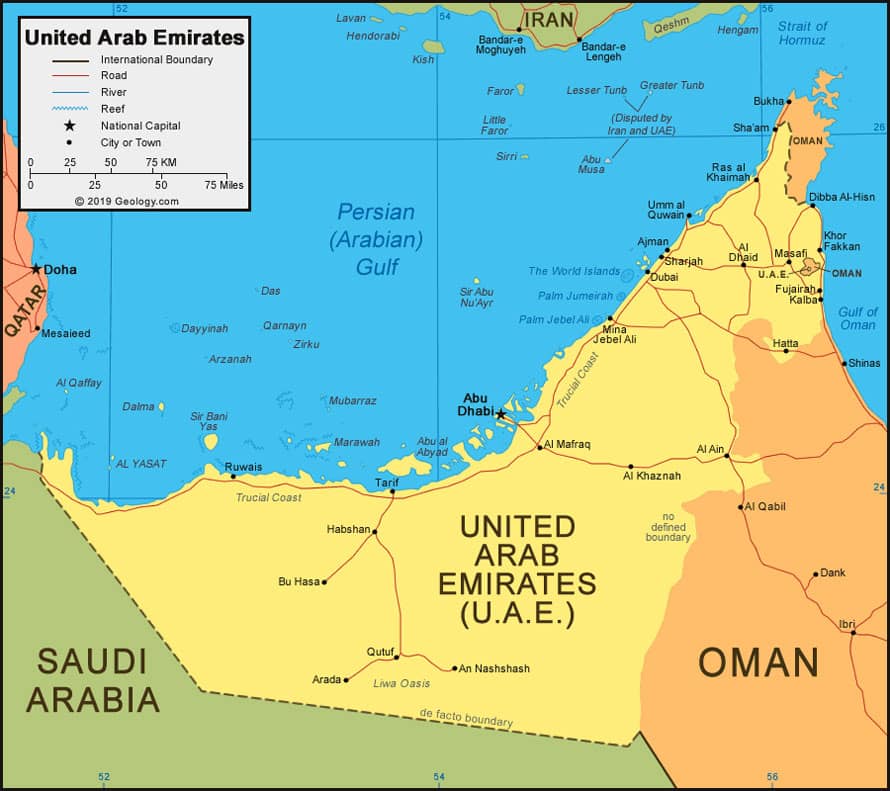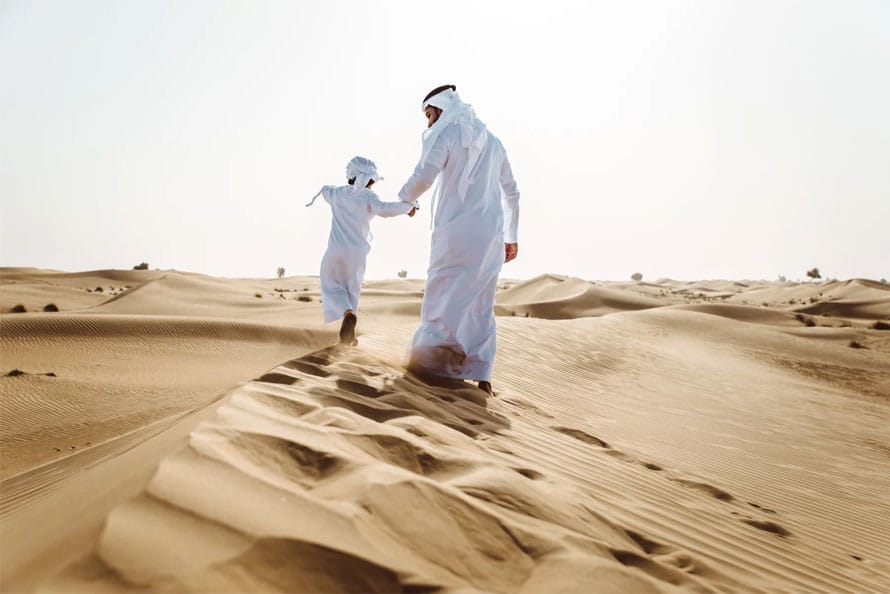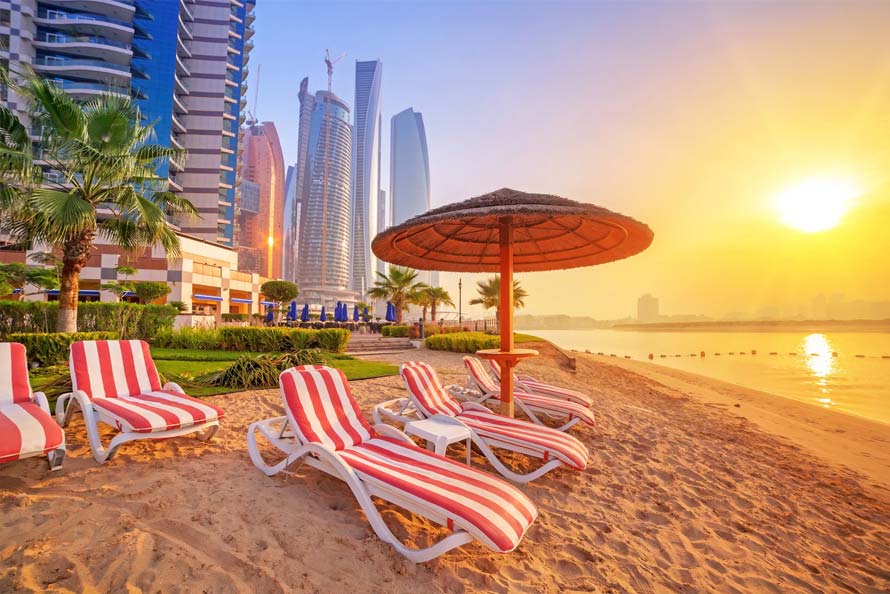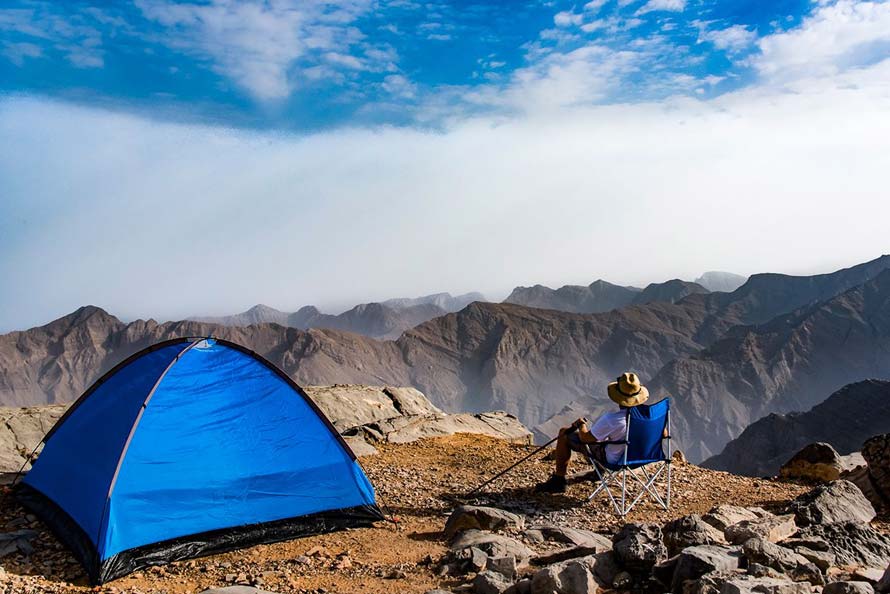Climate of UAE varies between mild and extreme temperatures. Whereby April to October have the highest temperatures, sometimes soaring above 100°F (38°C), best for indoor activities. The November to March phase has cooler temperatures, falling between 70s-80s°F (24-30°C), making it suitable for desert safaris, markets, and more.
With proper climate knowledge, you can pack and plan your visit wisely for a memorable stay. First, let’s discuss UAE geography and weather context.
The UAE's Geographical & Meteorological Context
The United Arab Emirates (UAE) is strategically located on the Arabian Peninsula’s southeastern tip, between the Persian Gulf to the west and the Oman Sea to the east. This region shares its borders with Saudi Arabia to the south and Oman to the northeast.

The UAE’s proximity to the Persian Gulf and the Oman Sea profoundly impacts its climate. The Persian Gulf’s shallow waters have a high heat-absorbing capacity, acting as a heat reservoir. Then, the trapped heat from warm air masses influences the UAE humidity and high temperatures, especially during the hot season.
The Oman Sea’s relatively calm waters offer a contrasting influence, moderating temperatures along the eastern coast.
Further, the coastal areas are characterized by milder conditions from the sea’s moderating effect. The Hajar Mountains in the east intercept moisture-laden winds, leading to rainfall increase on their windward side, creating a unique microclimate.
The interaction between UAE’s geography and meteorology affects its notable climate zones and general experiences.
Temperature in UAE Throughout the Year
Here’s a table with details on the average temperature in the United Arab Emirates (UAE) throughout the year.
Please note that the temperatures can vary slightly depending on the specific emirate within the UAE.
| Month | Average High (°C) | Average High (°F) | Average Low (°C) | Average Low (°F) |
|---|---|---|---|---|
| January | 24-26 | 75-79 | 14-16 | 57-61 |
| February | 24-26 | 75-79 | 15-17 | 59-63 |
| March | 28-32 | 82-90 | 17-19 | 63-66 |
| April | 32-37 | 90-99 | 20-23 | 68-73 |
| May | 36-41 | 97-106 | 24-27 | 75-81 |
| June | 39-43 | 102-109 | 27-30 | 81-86 |
| July | 41-45 | 106-113 | 29-32 | 84-90 |
| August | 41-45 | 106-113 | 30-32 | 86-90 |
| September | 38-42 | 100-108 | 27-30 | 81-86 |
| October | 34-38 | 93-100 | 23-26 | 73-79 |
| November | 30-33 | 86-91 | 19-22 | 66-72 |
| December | 25-28 | 77-82 | 15-17 | 59-63 |
These temperature ranges provide a general idea of the climate in United Arab Emirates, which includes Dubai. The specific temperatures may vary slightly from one emirate to another, but this table should give you an overview of the typical temperature patterns throughout the year in the UAE.
Exploring Key Climate Zones for Tourists
The United Arab Emirates (UAE) has a vast climatic zone tapestry influencing the travel experience.
When you want to visit the United Arab Emirates (UAE), it’s important to know about the different types of weather there. The UAE is a country with many exciting places to visit, from big cities to sandy deserts. But the weather can change a lot, depending on where you are.
In some parts of the UAE, like the desert, it can get very, very hot. You’ll feel like you’re in an oven! In other places, like the sea, it’s not as hot, and there’s a nice breeze.
Understanding the different weather in the UAE helps you plan your trip better. You’ll know when it’s best to go to the beach or when it’s better to explore the desert.
Importance of Understanding the UAE's Climate for Tourists
If you plan to travel to the UAE, here are some reasons you need to understand its climate.
- Optimal Planning
- Packing and Preparation
- Activity Selection
- Cultural Immersion
- Safety Awareness
Now you know why you must consider the UAE climate in your travel plans. Let’s explore its different climatic zones.
Desert Climate Experience
The United Arab Emirates (UAE) desert climate offers an exciting landscape of extremes. This climate provides arid conditions characteristics with sparse rainfall and extremely high temperatures. In addition, the golden sands and vast dunes unlock memorable experiences.

Temperature: During the scorching summer months, which typically span from June to September, temperatures can soar to well over 40 degrees Celsius (104 degrees Fahrenheit) and often exceed 45 degrees Celsius (113 degrees Fahrenheit). This intense heat can be challenging to endure, and residents and visitors alike seek refuge in air-conditioned spaces.
However, the desert’s temperature also exhibits remarkable fluctuations, with nights often cooling down significantly. In contrast, the winter season, from November to February, offers a more temperate climate with daytime temperatures ranging from a comfortable 20 to 30 degrees Celsius (68 to 86 degrees Fahrenheit), making it the ideal time for outdoor activities and exploration of UAE’s stunning desert landscapes.
However, here are valuable tips to enjoy UAE desserts.
- Keep hydrated in the desert's scorching heat. To achieve this, carry ample water and sip regularly to combat dehydration.
- Wear breathable and lightweight clothing as a shield against the intense sun.
- Wear a wide-brimmed hat and sunglasses for additional protection.
- Take and apply a Sunscreen cream to protect your skin from the sun.
Once you have the proper clothing, you can enjoy several activities in the desert. These include dune bashing and an exhilarating ride across the undulating sands to unleash your adrenaline.
Whichever experience you choose unveils the magic of the arid landscape and its undeniable allure.
Coastal Climate Enjoyment
Unlike the intense inland climate, UAE coastal regions offer a refreshing break. The area has moderate temperatures and refreshing sea breezes, creating a contrasting tranquility. Whereby you can indulge in leisurely beach lounging, partake in thrilling water sports, or embrace the allure of traditional dhow cruises.
However, you’ll need swimwear, light clothing, sunscreen, and sunglasses to enjoy the coasts. The climate presents a canvas of relaxation and adventure, inviting you to savor the perfect blend of sea, sand, and sunshine.

Temperature: Throughout the year, the country enjoys a maritime influence due to its proximity to the Persian Gulf. During the hot and humid summer months, which extend from May to October, daytime temperatures typically range from 30 to 40 degrees Celsius (86 to 104 degrees Fahrenheit), with high humidity levels making it feel even warmer.
However, the coastal location brings some relief as sea breezes help mitigate the heat, especially along the beaches and waterfront areas. In the cooler winter months, from November to April, temperatures range from a comfortable 20 to 30 degrees Celsius (68 to 86 degrees Fahrenheit), making it an ideal time for outdoor activities and enjoying Dubai’s beautiful coastal attractions.
Alternatively, you can also explore the mountainous regions.
Mountainous Climate Exploration
The United Arab Emirates (UAE) majestic Hajar Mountains offer a unique climate influence. The higher you go, the cooler the temperatures. Also, high-altitude areas have higher precipitation, creating a total contrast to the surrounding regions.
To explore these heights, brave yourself with sturdy hiking attire, comfortable footwear, and mountain adventure weather-appropriate gear for hiking and trekking.
Beyond the natural beauty, you’ll also explore diverse cultural encounters. The likes of traditional mountain villages unravel the region’s inhabitants’ heritage, providing insights into their lifestyles and customs.

Temperature: Though the country does not have significant mountainous terrain within its city limits. However, if one ventures beyond the city’s borders and into the surrounding regions, such as the Hajar Mountains in the eastern part of the United Arab Emirates, a different climate and temperature range can be experienced. In the Hajar Mountains, temperatures can vary significantly with altitude.
At lower elevations, the climate is more akin to the coastal area, offering milder temperatures during the winter months, ranging from 20 to 30 degrees Celsius (68 to 86 degrees Fahrenheit), while summers can still be quite warm. As one ascends higher into the mountains, temperatures drop, and it’s possible to encounter cooler conditions, even experiencing occasional frost and snowfall in the winter months.
The mountainous climate offers a cooler escape and a chance to connect with nature and local traditions. At least this paints a picture of the UAE beyond its iconic deserts and coastal havens.
*But the question remains: Which is the best time to visit the UAE?
Choosing the Ideal Time to Visit
Selecting the perfect time to visit the United Arab Emirates (UAE) is essential for a treasure trove of experiences. Your timing will help elevate your adventure while creating memories long after you’ve departed.
The UAE’s climate offers a diverse canvas of coast, desert, and mountains, shaping your opportunities. This creates the need to choose the right season to visit as an essential aspect of planning.

However, the best time to visit Dubai is from November to March. These months have cooler temperatures to enjoy its iconic skyline and abundant attractions.
The searing summer temperatures of the desert go down, allowing you to explore outdoor activities such as beach lounging, desert safaris, and full sightseeing without the sun’s intensity bearing you down.
Before you embark on your journey, here are valuable tips on the best time to visit Dubai. This article has helpful information to align your visit perfectly with your interests and aspirations.
Once you navigate the climate nuances and tap into local insights, you set the stage for a journey filled with beauty, culture, and adventure. Your timing is the primary catalyst for an extraordinary UAE exploration.
Get UAE Visa
As you now have a better understanding of the ideal time, temperatures, and climates in the UAE, it’s the perfect moment to pack your bags and embark on your journey to this fascinating destination.
Whether you’re drawn to the bustling cityscape of Dubai, the cultural treasures of Abu Dhabi, or the natural beauty of the UAE’s deserts and coastlines, there’s something for every traveler to discover. However, keep in mind that you’ll also need a visa to enter the country.
Thankfully, getting a UAE visa has never been more convenient. You can apply for it online from the comfort of your own home, eliminating the need for time-consuming visits to embassies or consulates. Simply meet the necessary requirements, submit your application online, and within just a few days, you’ll receive your approved visa right in your email inbox. With the travel logistics taken care of, you’re now one step closer to experiencing all that the UAE has to offer.
Clothing and Accessories
As you embark on a journey to the desert and coastal regions of UAE, you need the proper clothing and accessories for your comfort and enjoyment. Here are essential guidelines for you;

- Lightweight and Breathable Clothing: Choose loose-fitting, light, and breathable clothing. Preferably, these clothes should be made from natural fabrics like cotton to protect you from the sun and allow air circulation. Also, light colors are preferable to reflect the sun’s rays and help you stay more relaxed.
- Sun Protection: Sun protection is paramount in the UAE. It’s advisable to carry a wide-brimmed hat to shield your face, neck, and ears from the sun’s intense rays. Also, sunglasses with UV protection offer eye comfort and safeguard against harmful UV radiation.
- Sunscreen: Choose a broad-spectrum sunscreen with a high SPF rating to shield your skin from UVA and UVB rays. Apply generously and frequently, especially if you’re engaging in water-based activities.
- Footwear: Comfortable and sturdy footwear is crucial for desert and coastal exploration. Closed-toe shoes with good grip are recommended for desert hikes and dune activities. In contrast, sandals or water shoes are ideal for coastal walks and beach adventures.
- Scarves and Shawls: Pack lightweight scarves or shawls that can be versatile accessories. This means you can protect your neck from the sun, shield your shoulders in places of worship, or use it as a head cover if needed.
- Layering: For coastal visits, consider layering. Mornings and evenings might be cooler; in this case, a light jacket or cardigan can be handy. Helping you to adapt to changing temperatures throughout the day.
- Swimwear: Pack swimwear if you plan to enjoy the pristine coastal waters. Beaches and resorts offer ample opportunities for swimming and water sports.
In the UAE’s unique climate, proper clothing and accessories aren’t just about style but also for comfort and safety.
In addition to proper clothing, hydration, and general body health are equally important.
Hydration and Health
You must be vigilant on your hydration as you transverse the desert climate of the United Arab Emirates. The reason is that the scorching temperatures demand conscious efforts for your well-being.

The intense desert heat and dry air can cause rapid dehydration. Carry a reusable water bottle and sip water consistently throughout the day, even if you don’t feel thirsty.
In addition to hydrating, it’s essential to be cautious of heat-related illnesses like heat exhaustion and heatstroke, which sometimes can be severe. Dress in lightweight, breathable clothing, and take frequent breaks in shaded areas.
However, be more careful if you have pre-existing health conditions. Consult a healthcare professional before your trip, especially if you have heart conditions, diabetes, or respiratory issues. This is because some medications can influence your body’s response to heat.
Also, ask your healthcare provider if your medications could make you more susceptible to sunburn.
Additionally, allow your body time to adapt to the climate. To get used to the extreme heat, take it easy during the first few days of your trip. Then, gradually increase your outdoor activities as you adapt.
Finally, get essential emergency contacts, including local medical facilities and your country’s embassy. Also, it’s vital to have ready travel insurance that covers medical emergencies for your peace of mind.
Let’s explore applicable responsible tourism practices.
Responsible Tourism Practices
As you explore the UAE’s captivating landscapes, you must embrace accountable tourism to preserve its natural splendor and cultural heritage. Here are responsible tourism practices you need to consider.

- Choose accommodations and tours that prioritize sustainability. Eco-friendly resorts and tour operators implement practices that minimize negative environmental impact.
- Consider responsible spending by supporting local artisans, markets, and eateries. This enriches your cultural experience and also fosters local communities’ economic growth.
- Interact with locals and understand their way of life to fulfill the aspect of responsible tourism.
- Combatting plastic pollution is equally essential. To do this, carry a reusable water bottle and refill it to minimize plastics single-use.
- Use alternatives to plastic bags and straws.
- Dispose of your waste thoughtfully, recycling whenever possible.
- Consider taking part in organized clean-up events to make a positive impact.
- Respect the UAE's cultural norms and traditions. Dress modestly when visiting religious sites or public areas. Seek permission before photographing locals or their property. This helps to foster mutual respect and a positive exchange.
- Whether you explore deserts, coasts, or mountains, follow the "Leave No Trace" principle. Pack out all waste, avoid disturbing wildlife, and respect natural habitats. Leaving a place better than you found preserves its beauty for future generations.
The above tips help you showcase responsible tourism practices in your journey. Whereby you become a custodian of natural wonders and participate in cultural preservation.
Conclusion
The UAE is intricately intertwined with its diverse climate zones, offering visitors a rich tapestry of experiences. This creates the need to understand the geographical and meteorological factors shaping these zones to make the most of your travel adventure.
It’s geographical positioning on the Arabian Peninsula, in combination with the surrounding Persian Gulf and Oman Sea, molds its climate into distinct zones. The desert’s arid area offers impressive activities like dune bashing and camel riding, creating the need for careful hydration and sun protection.
The temperate coastal climate beckons tourists to enjoy beachside relaxation and invigorating water sports, best enjoyed in lightweight clothing and sufficient sun safeguards. Meanwhile, the mountainous regions provide cooler relief, ideal for trekking as you immerse in local culture.
However, you must choose the best time to visit to enjoy optimal experiences. By embracing eco-friendly choices and supporting local endeavors, you can tread responsibly on the UAE’s natural and cultural landscapes. The interconnectedness of climate awareness, positive experiences, and sustainable practices is evident.
As you prepare for your journey to the UAE, remember that beyond the gleaming skyscrapers lies a land of breathtaking diversity. Take caution of its climate as you immerse in its offerings, and embrace sustainable choices. This way, you enhance your adventure and contribute to preserving this captivating destination for generations to come.
So, as you embark on your UAE expedition, let climate consciousness be your compass and sustainability your guide.
But before that, visit UAE visa online to apply for your visa online seamlessly. No bulky paperwork nor visits to the embassy. You only need a few minutes to complete the form, and that’s it!
You are most welcome to UAE and have a nice journey!




